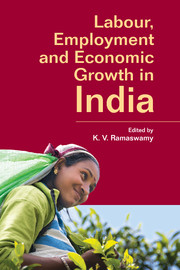Book contents
- Frontmatter
- Dedication
- Contents
- List of Tables and Figures
- Preface
- Part 1 Economic Growth and Employment
- Part 2 Employment and Labour Law
- 8 From Rigidity to Flexibility
- 9 Employment Protection Legislation and Threshold Effects
- 10 Who is a Worker?
- 11 Labour Jurisprudence of the Supreme Court
- Contributors
- Index
8 - From Rigidity to Flexibility
from Part 2 - Employment and Labour Law
Published online by Cambridge University Press: 05 June 2015
- Frontmatter
- Dedication
- Contents
- List of Tables and Figures
- Preface
- Part 1 Economic Growth and Employment
- Part 2 Employment and Labour Law
- 8 From Rigidity to Flexibility
- 9 Employment Protection Legislation and Threshold Effects
- 10 Who is a Worker?
- 11 Labour Jurisprudence of the Supreme Court
- Contributors
- Index
Summary
Introduction
For decades the Indian labour market has been regarded as highly rigid. Seeing it from the employers' perspective, it is clear that the employers have been legally restricted to restructure their labour force or layoff even a single worker, thanks to some job security provisions of the Industrial Disputes Act. When militant unions and bureaucratic red tapes are added to the job security laws, one gets the picture of an economy where large industries will be reluctant to make new hiring, because it will be difficult to shed them later.
It is also the case that the last 15 years' growth in the Indian economy, at least the manufacturing component of it, has led to a disproportionate expansion of the informal sector, accompanied by outsourcing and substitution of permanent labour for contract labour. Overall, the informal sector employment and the hiring of contract workers in the formal sector have gone up significantly. Critics might call these developments a swing to the other end of the rigidity scale – rampant flexibilization, or informalization of the Indian workforce. For a number of reasons one need not see this as a healthy trend. If the informal sector workers do not experience significant income gains, then the prospect of urban poverty reduction is grim. It is also the case that the informal firms are unlikely to graduate to the formal sector and offer a somewhat secure work environment to their workers. They are still regulation free like a ‘wild west of the cowboy capitalists’.
The question is whether there is an evolution of the middle ground, or is the labour market acting like a seesaw, or are these simply subversive acts? The rigidity has not disappeared, not in law and labour regulations, but the practice has allowed flexibility. Since practice is hard to regulate, the nature of flexibility will be determined by the incentives created by external and domestic opportunities, as well as the physical capabilities to respond to opportunities.
- Type
- Chapter
- Information
- Labour, Employment and Economic Growth in India , pp. 221 - 238Publisher: Cambridge University PressPrint publication year: 2015
- 1
- Cited by



